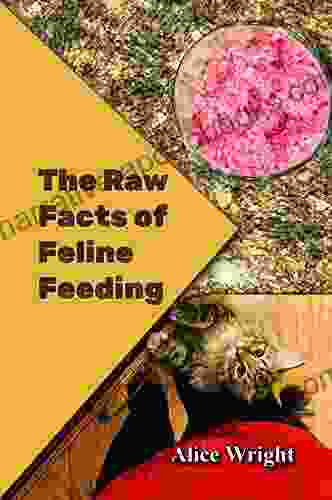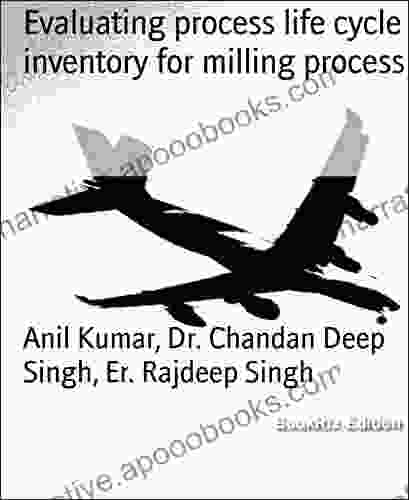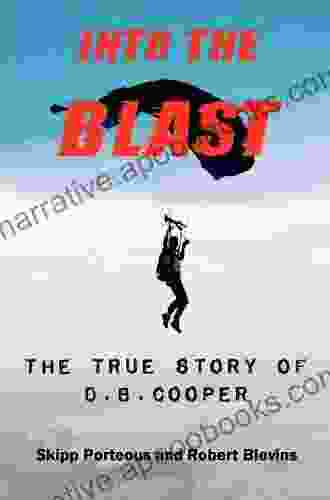Evaluating Process Life Cycle Inventory for Milling Process: A Comprehensive Guide

In the face of growing environmental concerns and the pressing need for sustainable manufacturing practices, process life cycle inventory (LCI) has emerged as a vital tool for assessing the environmental impact of industrial processes. This article delves into the world of LCI, specifically focusing on its application in the milling process, providing a comprehensive guide to its principles, methodologies, challenges, and applications. By understanding the intricacies of LCI, milling industry stakeholders can gain valuable insights into the environmental footprint of their operations, paving the way for informed decision-making and the adoption of sustainable practices.
4.6 out of 5
| Language | : | English |
| File size | : | 531 KB |
| Text-to-Speech | : | Enabled |
| Screen Reader | : | Supported |
| Enhanced typesetting | : | Enabled |
| Word Wise | : | Enabled |
| Print length | : | 59 pages |
Understanding Process Life Cycle Inventory (LCI)
Process LCI is a fundamental stage within the broader life cycle assessment (LCA) framework, which evaluates the environmental performance of a product or process throughout its entire life cycle. LCI involves the systematic collection and quantification of data on the inputs and outputs associated with a specific process, including raw materials, energy consumption, emissions, and waste generation.
Key Principles of LCI
* System Boundaries: Clearly defining the scope and boundaries of the process under investigation is crucial to ensure a comprehensive and accurate assessment. * Inventory Data: Gathering reliable and detailed data on all relevant inputs and outputs is essential for establishing a robust LCI. * Allocation: When a process generates multiple products or involves multiple stages, appropriate allocation methods must be employed to distribute the environmental impacts accordingly. * Life Cycle Stages: LCI typically considers the following stages: raw material extraction, production, use, and end-of-life. * Impact Assessment: The collected inventory data is subsequently used to calculate the environmental impacts associated with the process, such as global warming potential, acidification, and resource depletion.
Milling Process: An Overview
Milling is a fundamental manufacturing process widely employed in various industries, including food processing, pharmaceuticals, and metalworking. It involves the mechanical reduction of a solid material into smaller particles through grinding, cutting, or crushing. The milling process can be categorized into several types based on the specific equipment and techniques used, such as ball milling, roll milling, and hammer milling.
LCI for Milling Process: Methodologies
Conducting an LCI for a milling process typically involves the following steps:
1. Goal and Scope Definition: Establish the purpose and boundaries of the LCI, including the specific milling process and the life cycle stages to be assessed. 2. Inventory Analysis: Collect and quantify data on the inputs (e.g., raw materials, energy) and outputs (e.g., emissions, waste) associated with the milling process. 3. Allocation: If the milling process generates multiple products or involves multiple stages, allocate the environmental impacts appropriately. 4. Life Cycle Impact Assessment (LCIA): Convert the inventory data into environmental impact indicators using standardized assessment methods, such as those provided by the International Organization for Standardization (ISO).
Challenges in LCI for Milling Processes
Conducting LCI for milling processes presents several challenges that need to be addressed:
* Data Availability and Reliability: Obtaining accurate and comprehensive data on all relevant inputs and outputs can be challenging, especially for complex milling processes. * Allocation Methods: The selection of appropriate allocation methods is critical to ensure fair and consistent distribution of environmental impacts, particularly when multiple products or stages are involved. * Variability in Milling Processes: Milling processes can vary significantly depending on the specific material being processed, the equipment used, and the operating conditions, which can introduce uncertainty into the LCI results. * Dynamic Nature of Milling Systems: Milling processes often involve dynamic interactions between different components and stages, making it challenging to capture the full complexity of the system in the LCI.
Applications of LCI in Milling Processes
LCI plays a vital role in various applications related to milling processes:
* Environmental Performance Evaluation: LCI enables the assessment of the environmental footprint of milling processes, allowing manufacturers to identify areas for improvement and reduce their impact. * Product Design and Development: LCI can inform product design and development by providing insights into the environmental implications of different material choices and production methods. * Process Optimization: By evaluating the environmental performance of different process configurations and operating parameters, LCI can guide process optimization efforts towards sustainability. * Benchmarking and Transparency: LCI data can facilitate benchmarking and comparison of milling processes across different facilities or industries, promoting transparency and the sharing of best practices. * Eco-labeling and Certification: LCI results can support eco-labeling and certification programs, enabling manufacturers to communicate the environmental performance of their milling processes to consumers and stakeholders.
Case Study: LCI for Wheat Milling
To illustrate the application of LCI in milling processes, consider the example of wheat milling. Wheat milling involves the transformation of wheat grains into flour through a series of grinding and sifting operations. LCI for wheat milling can provide valuable insights into the environmental impact of different milling technologies, energy sources, and waste management practices. By identifying the hotspots and inefficiencies in the milling process, manufacturers can implement targeted measures to reduce their environmental footprint, such as optimizing energy consumption or adopting sustainable waste management strategies.
Process life cycle inventory (LCI) is a powerful tool that enables the comprehensive evaluation of the environmental impact of milling processes. By understanding the principles, methodologies, challenges, and applications of LCI, milling industry stakeholders can gain valuable insights into the sustainability of their operations. Embracing LCI practices empowers manufacturers to make informed decisions, optimize processes, and contribute to the creation of a more sustainable and environmentally conscious milling industry. As technology and methodologies continue to evolve, LCI will remain an indispensable tool for driving sustainability in the milling sector and beyond.
4.6 out of 5
| Language | : | English |
| File size | : | 531 KB |
| Text-to-Speech | : | Enabled |
| Screen Reader | : | Supported |
| Enhanced typesetting | : | Enabled |
| Word Wise | : | Enabled |
| Print length | : | 59 pages |
Do you want to contribute by writing guest posts on this blog?
Please contact us and send us a resume of previous articles that you have written.
 Book
Book Novel
Novel Page
Page Chapter
Chapter Text
Text Story
Story Genre
Genre Reader
Reader Library
Library Paperback
Paperback E-book
E-book Magazine
Magazine Newspaper
Newspaper Paragraph
Paragraph Sentence
Sentence Bookmark
Bookmark Shelf
Shelf Glossary
Glossary Bibliography
Bibliography Foreword
Foreword Preface
Preface Synopsis
Synopsis Annotation
Annotation Footnote
Footnote Manuscript
Manuscript Scroll
Scroll Codex
Codex Tome
Tome Bestseller
Bestseller Classics
Classics Library card
Library card Narrative
Narrative Biography
Biography Autobiography
Autobiography Memoir
Memoir Reference
Reference Encyclopedia
Encyclopedia Alphonse De Lamartine
Alphonse De Lamartine Alissa Burger
Alissa Burger Togzhan Kassenova
Togzhan Kassenova Jean Giono
Jean GionoS M D
 David Cox
David Cox Paul Fischer
Paul Fischer Jane Halliwell Green
Jane Halliwell Green Marty Becker
Marty Becker Claire Angel
Claire Angel Jen Hadfield
Jen Hadfield Michaela J Compton
Michaela J Compton J D Barker
J D Barker Guy Geltner
Guy Geltner Will Vaus
Will Vaus Scott Kaye
Scott Kaye Allan Swenson
Allan Swenson Ray Pratt
Ray Pratt Megan Chance
Megan Chance Etel Adnan
Etel Adnan
Light bulbAdvertise smarter! Our strategic ad space ensures maximum exposure. Reserve your spot today!

 Gene SimmonsUnlocking the Secrets of Optimal Cat Nutrition: An In-Depth Exploration of...
Gene SimmonsUnlocking the Secrets of Optimal Cat Nutrition: An In-Depth Exploration of... Dakota PowellFollow ·19.1k
Dakota PowellFollow ·19.1k Edwin BlairFollow ·9.7k
Edwin BlairFollow ·9.7k David MitchellFollow ·7.5k
David MitchellFollow ·7.5k Isaiah PriceFollow ·13.8k
Isaiah PriceFollow ·13.8k Jerry WardFollow ·4.5k
Jerry WardFollow ·4.5k Evan SimmonsFollow ·4.5k
Evan SimmonsFollow ·4.5k Owen SimmonsFollow ·16.5k
Owen SimmonsFollow ·16.5k Cason CoxFollow ·14.5k
Cason CoxFollow ·14.5k

 F. Scott Fitzgerald
F. Scott FitzgeraldUnravel the Enigmatic Murder of Mary Russell: A...
Prologue: A Grisly Discovery In the...

 Connor Mitchell
Connor MitchellLittle Quilts: Gifts from Jelly Roll Scraps
Embrace the Art...

 Harold Powell
Harold PowellPoverty Survival Hope In An American City: A Pulitzer...
A testament to the resilience of the human...

 Ray Blair
Ray BlairConfronting Global Warming: Population, Resources, and...
Global warming is one of the most pressing...

 Gary Cox
Gary CoxStyle Your Most Authentic Self and Cultivate a Mindful...
Unlock Your True...

 Caleb Long
Caleb LongEmbark on a Colorful Patchwork Adventure: Discover 20 To...
Step into the captivating world of...
4.6 out of 5
| Language | : | English |
| File size | : | 531 KB |
| Text-to-Speech | : | Enabled |
| Screen Reader | : | Supported |
| Enhanced typesetting | : | Enabled |
| Word Wise | : | Enabled |
| Print length | : | 59 pages |










